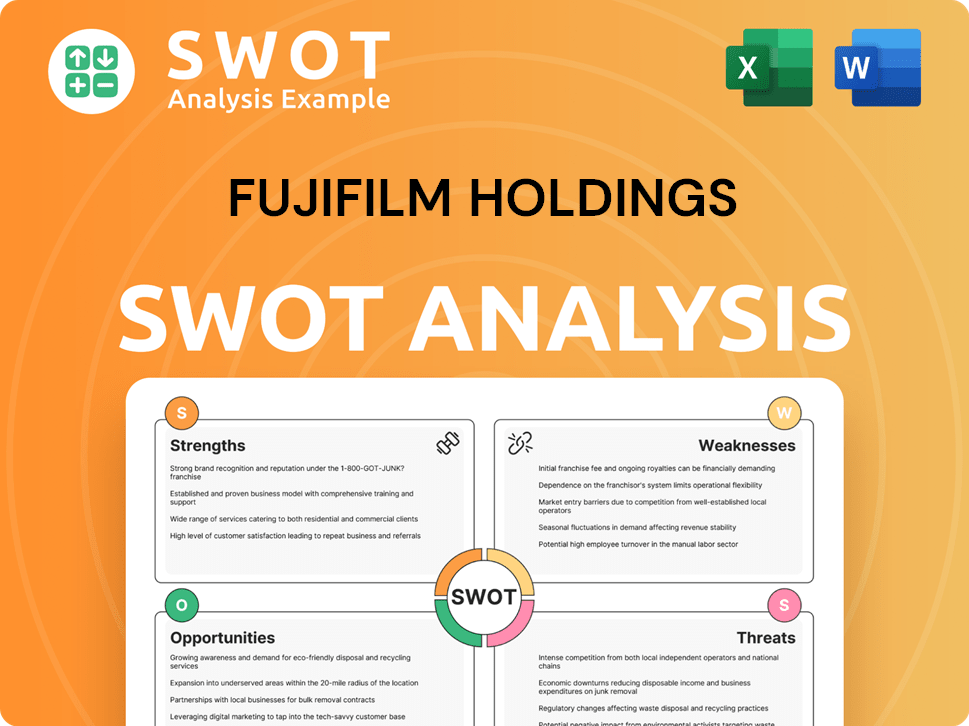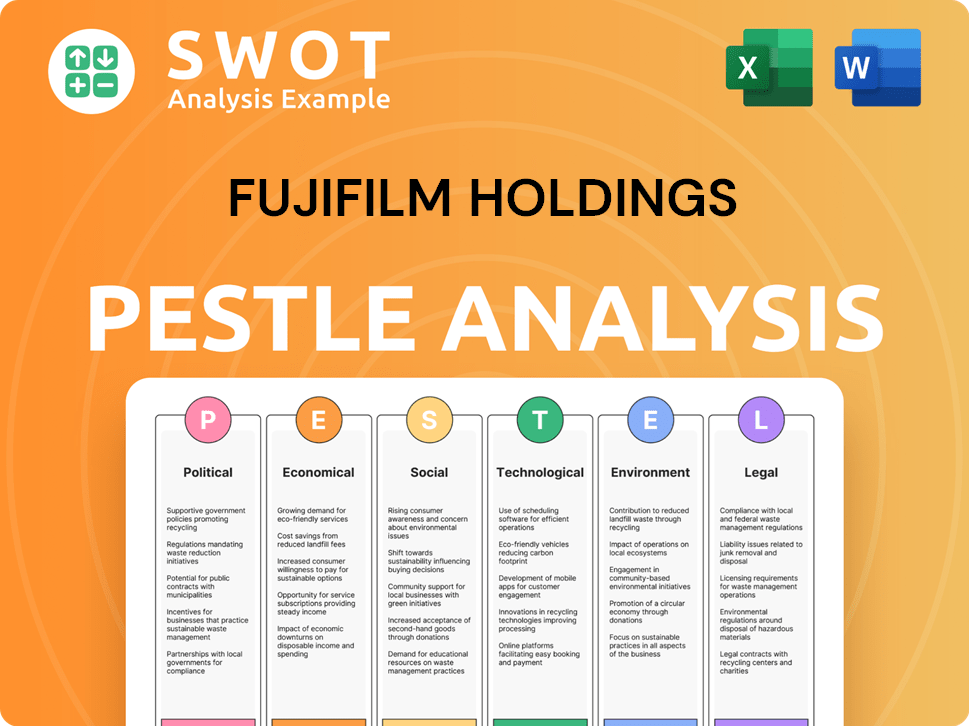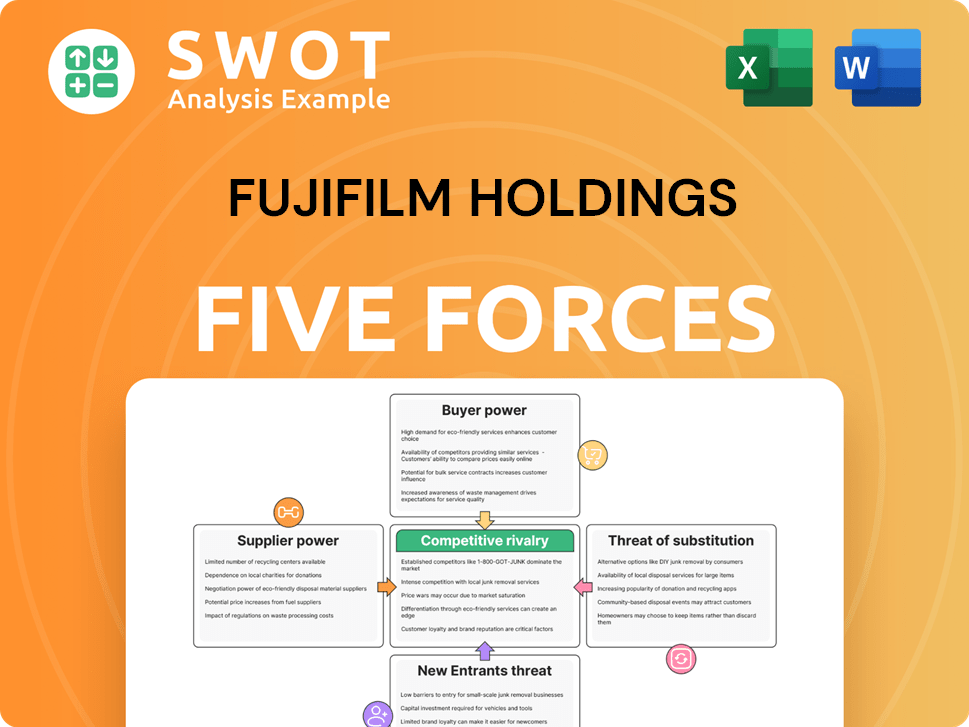Fujifilm Holdings Bundle
How Well Does Fujifilm Know Its Customers?
Once a titan of photographic film, Fujifilm Holdings Company has dramatically transformed. Today, the company's success hinges on understanding its diverse customer demographics and target markets across imaging, healthcare, and materials. This shift requires a deep dive into who Fujifilm's ideal customers are and how the company caters to their evolving needs.

From its origins in 1934 Japan, Fujifilm's consumer base has expanded significantly. Understanding the Fujifilm Holdings SWOT Analysis reveals the importance of its customer segmentation strategy. This analysis of Fujifilm's market share by customer segment and consumer behavior analysis is critical for strategic planning and sustained growth. Fujifilm's customer profile now spans various age ranges, income levels, and geographic markets, each with unique preferences and needs.
Who Are Fujifilm Holdings’s Main Customers?
Understanding the customer demographics Fujifilm serves is crucial for grasping its market position. Fujifilm Holdings Company operates in both business-to-consumer (B2C) and business-to-business (B2B) segments, each with distinct characteristics and needs. This dual approach allows the company to cater to a broad range of customers, from individual consumers to large corporations and institutions.
The Fujifilm target market is diverse, reflecting the company's wide array of products and services. In the B2C sector, Fujifilm focuses on photography enthusiasts and casual users, particularly those interested in instant photography with products like Instax cameras. The B2B segment, however, targets healthcare providers, pharmaceutical companies, and various manufacturing industries, offering medical imaging systems, advanced materials, and other specialized solutions. This dual approach allows Fujifilm to maintain a robust market presence and adapt to changing consumer and business needs.
Analyzing the Fujifilm customer profile reveals a strategic segmentation approach. The B2C segment often includes younger demographics, such as Gen Z and millennials, who are drawn to the instant gratification and creative expression offered by products like Instax cameras. Conversely, the B2B segment comprises organizations seeking high-performance and reliable solutions, with purchasing decisions often based on technological capabilities and cost-efficiency. This segmentation helps Fujifilm tailor its products, marketing, and sales strategies to meet the specific needs of each customer group.
The B2C segment primarily targets photography enthusiasts and casual users. This includes younger demographics (Gen Z and millennials) interested in instant photography. The Instax series remains popular, contributing significantly to the consumer imaging business. Fujifilm's consumer base is geographically diverse, with strong sales in Asia, North America, and Europe.
The B2B segment includes hospitals, clinics, pharmaceutical companies, and research institutions. Fujifilm provides medical imaging systems, endoscopy systems, and pharmaceutical products to healthcare providers. In the materials segment, the company supplies advanced materials to industries like electronics and automotive. This segment's purchasing decisions are driven by technological capabilities and regulatory compliance.
Fujifilm's key market segments include consumer imaging (cameras and photo printing), healthcare (medical imaging and pharmaceuticals), and materials (advanced materials for various industries). The healthcare segment has been a significant growth driver, with substantial revenue reported in recent financial reports. The company continues to invest in expanding its presence in these key areas.
Fujifilm has a global presence, with significant markets in Asia, North America, and Europe. The company's geographic strategy involves tailoring products and services to meet regional needs. Fujifilm’s revenue is diversified across these regions, with ongoing efforts to expand its footprint in emerging markets. For example, in 2024, Fujifilm announced plans to further expand its healthcare business in the Asia-Pacific region.
Fujifilm's customer segmentation strategy is designed to address the diverse needs of its B2C and B2B customers effectively. This approach allows the company to tailor its products, marketing, and sales efforts to specific customer groups, maximizing market penetration and revenue generation. The company's success is also influenced by its Marketing Strategy of Fujifilm Holdings.
- Consumer Imaging: Focus on younger demographics (Gen Z and millennials) with Instax cameras and photo printing services.
- Healthcare: Target hospitals, clinics, and medical professionals with medical imaging systems and pharmaceuticals.
- Materials: Serve industries such as electronics and automotive with advanced materials.
- Geographic Focus: Tailor products and services to meet regional needs in Asia, North America, and Europe.
Fujifilm Holdings SWOT Analysis
- Complete SWOT Breakdown
- Fully Customizable
- Editable in Excel & Word
- Professional Formatting
- Investor-Ready Format

What Do Fujifilm Holdings’s Customers Want?
Understanding the customer needs and preferences is crucial for Fujifilm Holdings Company to tailor its products and services effectively. The company's diverse portfolio, spanning imaging solutions to healthcare technologies, caters to a wide range of customer segments. Analyzing the needs and preferences of these segments allows Fujifilm to innovate, improve customer satisfaction, and maintain a competitive edge in the market. This approach is vital for Fujifilm's strategic planning and market positioning.
Fujifilm's customer base exhibits varied needs, motivations, and preferences depending on the sector. In the B2C imaging sector, customers prioritize ease of use, creative features, and the ability to capture and share moments instantly. In the B2B healthcare sector, customer needs are driven by clinical efficacy, reliability, patient safety, and technological advancement. Fujifilm addresses these needs through focused R&D, product innovation, and targeted marketing strategies.
Customer demographics for Fujifilm vary widely, but understanding these segments is key for effective marketing and product development. The company's approach to customer satisfaction and market analysis is multifaceted, ensuring that it meets the diverse needs of its broad consumer base. This customer-centric strategy supports Fujifilm's long-term growth and market leadership.
Customers in the B2C imaging sector, such as those using Instax cameras, value ease of use and creative features. They often seek products that align with their lifestyle and personal expression. These consumers are frequently engaged with brand communities and prioritize the ability to capture and share moments instantly.
Instax users, a significant segment of Fujifilm's consumer base, are driven by the tangible print and the nostalgic experience of instant photography. Their purchasing decisions are often influenced by aesthetic appeal and social sharing capabilities. The popularity of Instax cameras highlights the importance of understanding specific consumer preferences within the imaging sector.
In the B2B healthcare sector, Fujifilm's customers, including hospitals and medical professionals, prioritize clinical efficacy, reliability, and technological advancement. They seek imaging systems that offer high diagnostic accuracy and efficient workflows. Pharmaceutical companies also rely on Fujifilm for cutting-edge drug discovery solutions and manufacturing capabilities.
Customer needs in healthcare are driven by the need for high diagnostic accuracy, efficient workflows, and integration with existing IT infrastructure. Fujifilm addresses these needs by focusing on R&D and introducing advanced medical technologies and therapeutic solutions. The company's approach includes tailoring its marketing and sales efforts to highlight clinical benefits and compliance with industry standards.
Fujifilm tailors its marketing and sales approach to highlight clinical benefits, return on investment, and compliance with industry standards. Customer feedback in this segment heavily influences product development, leading to innovations that address specific pain points such as diagnostic speed or treatment outcomes. This customer-centric approach is crucial for maintaining a competitive edge.
Fujifilm's commitment to R&D is evident in its continuous introduction of advanced medical technologies and therapeutic solutions. This focus allows the company to meet the evolving needs of its customers in the healthcare sector. Investments in R&D are critical for maintaining a competitive advantage and driving innovation in the industry.
Fujifilm's ability to understand and meet customer needs is a core part of its business strategy. This involves tailoring products, marketing, and sales approaches to align with the specific requirements of each customer segment. The company's success is heavily influenced by its ability to adapt to changing market dynamics and customer preferences. For a deeper dive into the company's history and evolution, consider reading Brief History of Fujifilm Holdings.
- B2C Imaging: Ease of use, creative features, instant sharing, aesthetic appeal, and brand community engagement.
- B2B Healthcare: Clinical efficacy, reliability, patient safety, technological advancement, diagnostic accuracy, efficient workflows, and integration with IT infrastructure.
- Pharmaceuticals: Cutting-edge drug discovery solutions and manufacturing capabilities.
- Instax Users: Tangible prints, nostalgic experience, social sharing, and lifestyle alignment.
- Marketing Strategy: Highlighting clinical benefits, ROI, and industry compliance in the healthcare sector.
Fujifilm Holdings PESTLE Analysis
- Covers All 6 PESTLE Categories
- No Research Needed – Save Hours of Work
- Built by Experts, Trusted by Consultants
- Instant Download, Ready to Use
- 100% Editable, Fully Customizable

Where does Fujifilm Holdings operate?
Geographical market presence is a critical aspect of the business strategy for Fujifilm Holdings Corporation. The company has a strong and diverse global footprint, with significant operations and market share across various regions. Its success is built on a strategic approach to market penetration and adaptation to regional demands.
Key markets for Fujifilm include Japan, North America (the United States and Canada), Europe (Germany, the United Kingdom, and France), and Asia (China, India, and Southeast Asia). Fujifilm's approach involves leveraging its established brand recognition and distribution networks in developed economies while simultaneously expanding its healthcare and materials businesses into emerging markets. This strategy helps maintain its market position and capitalize on growth opportunities.
Fujifilm's customer profile varies significantly across different regions and product lines. For instance, in North America and Europe, Fujifilm's customer base includes healthcare providers, graphic arts professionals, and consumers interested in imaging products. In Asia, particularly in China and India, Fujifilm is targeting healthcare providers, pharmaceutical companies, and a growing consumer base with increasing healthcare needs and disposable incomes. Understanding the Fujifilm target market in each region is crucial for tailoring products, marketing messages, and service models to meet specific regional preferences and regulatory requirements.
Fujifilm has a strong presence in medical imaging and graphic systems. The company leverages established distribution networks and brand recognition. Diagnostic imaging systems are widely used in hospitals across the U.S. and Canada.
Similar to North America, Fujifilm focuses on medical imaging and graphic systems. It uses established distribution networks and brand recognition in key markets like Germany, the UK, and France. The company's diagnostic imaging systems are widely used in hospitals.
Fujifilm is actively expanding its healthcare and pharmaceutical businesses, especially in China and India. This expansion is driven by growing healthcare expenditures and increasing demand for advanced medical technologies. The company tailors its offerings to suit regional preferences.
As Fujifilm's home market, Japan remains a crucial region for its overall strategy. The company maintains a strong presence in its legacy imaging businesses while continuing to innovate in healthcare and materials.
Fujifilm's customer segmentation strategy involves adapting its products and services to meet the specific needs of each region. This includes tailoring product features, marketing messages, and service models to suit regional preferences and regulatory requirements. For example, certain medical devices might be tailored to specific healthcare infrastructure or patient demographics prevalent in a particular country. This localized approach is a key factor in the company's success in diverse markets. To learn more about the company's growth strategy, you can read this article about the Growth Strategy of Fujifilm Holdings.
Fujifilm is actively expanding its healthcare and pharmaceutical businesses globally. This expansion is particularly focused on emerging markets where healthcare expenditures are increasing. The company aims to capitalize on the growing demand for advanced medical technologies.
Fujifilm customizes its offerings by adapting product features, marketing messages, and service models to suit regional preferences and regulatory requirements. This approach ensures that products meet the specific needs of each market. Tailoring is key to success.
The company is increasingly focusing on its healthcare and biopharmaceutical sectors. This reflects a strategic shift in geographical investment and sales focus. Healthcare is a major growth area.
Recent expansions have focused on bolstering its presence in the life sciences and biopharmaceutical sectors globally. This strategic move reflects a shift towards high-growth areas. The company is investing in key regions.
Fujifilm employs various customer acquisition strategies, including partnerships and direct sales. They tailor these strategies to the specific needs of each region. Understanding the Fujifilm customer profile is essential.
Fujifilm's market share varies by segment and region, with strong positions in its legacy imaging businesses in developed economies. The company is working to increase its market share in emerging markets. Fujifilm's market analysis is ongoing.
Fujifilm Holdings Business Model Canvas
- Complete 9-Block Business Model Canvas
- Effortlessly Communicate Your Business Strategy
- Investor-Ready BMC Format
- 100% Editable and Customizable
- Clear and Structured Layout

How Does Fujifilm Holdings Win & Keep Customers?
To understand the customer acquisition and retention strategies of the company, it's essential to consider its diverse business segments. The strategies vary significantly between business-to-consumer (B2C) and business-to-business (B2B) markets. For instance, the approach for its imaging products, such as Instax cameras, differs considerably from its healthcare solutions.
In the B2C sector, the company focuses on building brand awareness and loyalty through social media, influencer collaborations, and experiential marketing, particularly targeting younger demographics. Digital advertising and e-commerce platforms are crucial for acquiring new customers. Loyalty programs and community engagement are also key to retaining customers. The company’s market analysis reveals distinct customer preferences based on age, income levels, and consumer behavior, informing targeted marketing campaigns.
For B2B segments, the company relies heavily on direct sales forces, industry conferences, trade shows, and strategic partnerships. Customer acquisition in healthcare involves detailed product demonstrations, clinical trials, and value-based selling. Retention strategies in B2B emphasize after-sales service, technical support, and continuous product innovation. The company uses customer data and CRM systems for personalized communication and proactive support. This approach helps maintain high customer lifetime value, especially in divisions like medical systems.
The company's B2C customer acquisition strategies heavily rely on digital marketing. This includes targeted online campaigns, social media marketing, and collaborations with influencers to reach younger audiences. E-commerce platforms also play a crucial role in driving sales and attracting new customers. These efforts are designed to align with the company's understanding of its customer demographics.
In B2B segments, the company employs a direct sales approach, participating in industry conferences and trade shows. Strategic partnerships are also vital for acquiring new clients. For healthcare solutions, the sales cycle is extended, involving detailed product demonstrations and clinical trials. The company focuses on building long-term relationships with its business clients.
Loyalty programs and community engagement initiatives are key to retaining B2C customers. The company fosters brand loyalty through these programs, creating a sense of belonging among its customer base. By understanding its consumer base, the company tailors its retention strategies to meet specific customer preferences.
Excellent after-sales service, technical support, and continuous product innovation are central to B2B retention. The company also provides ongoing training for medical professionals and regular software updates in its medical systems division. These efforts help maintain high customer lifetime value.
The company's customer acquisition and retention strategies are data-driven, utilizing CRM systems to segment clients and personalize communications. For instance, in its medical systems division, ongoing training for medical professionals and regular software updates contribute to high customer lifetime value. The company's commitment to research and development is also critical for retaining customers by offering advanced solutions. For more insights, consider reading another article about the company's market strategies.
The company leverages digital advertising, targeted online campaigns, and e-commerce to acquire new customers, particularly in B2C segments. Social media and influencer collaborations are key strategies. These initiatives help to reach a wider audience and enhance brand visibility.
Direct sales forces and strategic partnerships are essential for B2B customer acquisition. Participation in industry conferences and trade shows also plays a significant role. These strategies are designed to build strong relationships with business clients.
The company uses customer data and CRM systems to segment B2B clients. This enables personalized communication and tailored solution offerings. CRM systems are crucial for providing proactive support.
Loyalty programs and community engagement initiatives are crucial for retaining B2C customers. These programs help to foster brand loyalty and create a sense of community. These efforts help to understand and meet specific customer preferences.
Excellent after-sales service and technical support are central to B2B retention. Continuous product innovation and regular software updates are also key. These services ensure high customer lifetime value.
The company emphasizes research and development to retain customers. This involves consistently offering advanced and competitive solutions. This commitment helps to maintain a competitive edge.
Fujifilm Holdings Porter's Five Forces Analysis
- Covers All 5 Competitive Forces in Detail
- Structured for Consultants, Students, and Founders
- 100% Editable in Microsoft Word & Excel
- Instant Digital Download – Use Immediately
- Compatible with Mac & PC – Fully Unlocked

Related Blogs
- What are Mission Vision & Core Values of Fujifilm Holdings Company?
- What is Competitive Landscape of Fujifilm Holdings Company?
- What is Growth Strategy and Future Prospects of Fujifilm Holdings Company?
- How Does Fujifilm Holdings Company Work?
- What is Sales and Marketing Strategy of Fujifilm Holdings Company?
- What is Brief History of Fujifilm Holdings Company?
- Who Owns Fujifilm Holdings Company?
Disclaimer
All information, articles, and product details provided on this website are for general informational and educational purposes only. We do not claim any ownership over, nor do we intend to infringe upon, any trademarks, copyrights, logos, brand names, or other intellectual property mentioned or depicted on this site. Such intellectual property remains the property of its respective owners, and any references here are made solely for identification or informational purposes, without implying any affiliation, endorsement, or partnership.
We make no representations or warranties, express or implied, regarding the accuracy, completeness, or suitability of any content or products presented. Nothing on this website should be construed as legal, tax, investment, financial, medical, or other professional advice. In addition, no part of this site—including articles or product references—constitutes a solicitation, recommendation, endorsement, advertisement, or offer to buy or sell any securities, franchises, or other financial instruments, particularly in jurisdictions where such activity would be unlawful.
All content is of a general nature and may not address the specific circumstances of any individual or entity. It is not a substitute for professional advice or services. Any actions you take based on the information provided here are strictly at your own risk. You accept full responsibility for any decisions or outcomes arising from your use of this website and agree to release us from any liability in connection with your use of, or reliance upon, the content or products found herein.